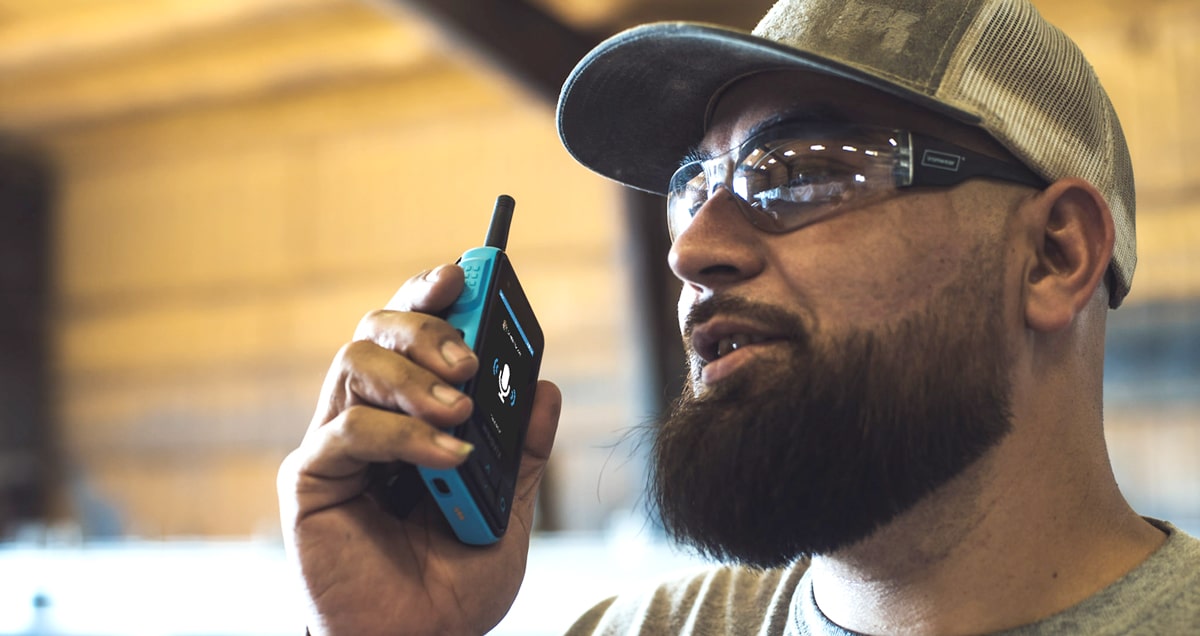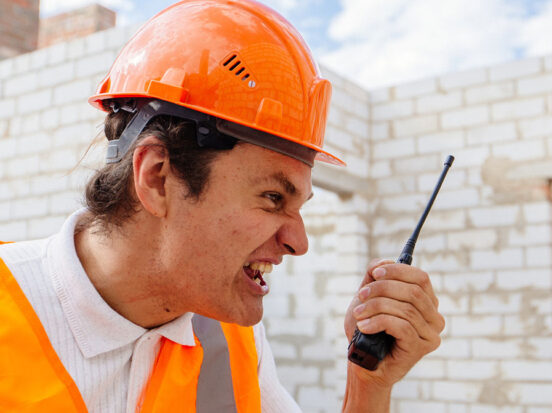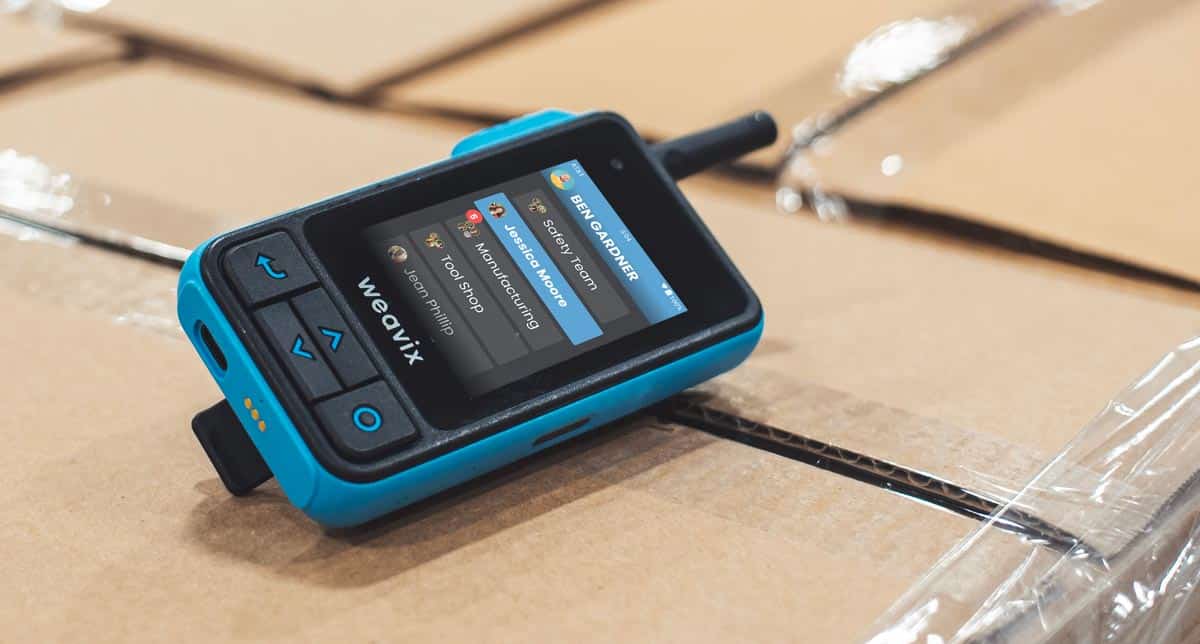What happens if your workers have to deal with misunderstandings on the frontline? The rules of radio etiquette were developed to prevent the consequences of missing even a single message. Clear communication is the difference between your team shutting down a faulty production line as soon as they spot a problem and that same line wasting thousands of dollars in defective goods, unplanned downtime, and repair costs.
When you and your team understand the right way to use your radios, you’ll create a safer, more efficient work environment. In this guide, we explain radio communication etiquette, why you should prioritize it, and the 11 rules of etiquette for frontline teams.
Key highlights:
- Radio communication etiquette is the set of rules and best practices that ensure clear, consistent, and reliable exchanges over radios on the frontline.
- The four golden rules of radio communication — clarity, simplicity, brevity, and security — provide a foundation for effective use in any industry.
- Updating walkie-talkie etiquette for today’s operations improves operations’ safety, reduces downtime, and gives leaders better visibility across teams.
- Modern smart radios like the Walt® Smart Radio System extend proper two-way radio etiquette with features like real-time translation, automatic logging, and photo/video sharing.
What Is Radio Etiquette?
Radio etiquette is the set of rules and best practices that keep two-way conversations clear, concise, and reliable in high-stakes environments. On the frontline, poor etiquette creates confusion, delays, and safety risks.
Most traditional etiquette guidelines were created decades ago to account for the limits of legacy two-way radio systems, where static, channel congestion, and limited functionality made clear communication difficult. While those basics are still useful, today’s frontline teams need more.
For plant managers, supervisors, and safety leaders, radio communication etiquette is about:
- Making sure workers can share updates without delays or repeated clarifications
- Reducing miscommunication in noisy or multilingual environments
- Keeping sensitive information secure while still moving quickly
Creating consistent habits so every worker, no matter their role or shift, communicates in the same way.
Why Your Business Should Prioritize Proper Radio Etiquette
Your business should prioritize proper radio etiquette because clear communication directly impacts safety, efficiency, and productivity. Without it, workers risk delays, missed updates, and costly mistakes on the production floor. In fact:
Proper two-way radio etiquette reduces miscommunication that leads to downtime
Knowing how to use the radio keeps safety alerts clear and immediate
Following radio communication protocols creates consistency across teams and shifts, improving overall efficiency
Smart radios reinforce these practices by automating speaker ID, logging conversations, and even translating messages in real time — ensuring good etiquette is built into every interaction.
4 Golden Rules of Radio Communication
The four golden rules of radio communication are the foundation of proper radio etiquette. They keep every message clear, fast, and reliable, no matter the environment or the size of your team.
| Basic Two-Way Radio Etiquette Golden Rules | What It Means in Radio Communication |
|---|---|
| Clarity | Speak slowly and clearly. Hold the microphone a few inches from your mouth so every word comes through without distortion. |
| Simplicity | Use plain, straightforward language that everyone can understand. Avoid jargon, technical terms, or complex phrases that might confuse listeners. Choose simple words over complicated ones, and break complex instructions into smaller, digestible parts. |
| Brevity | Keep messages short and to the point. Limit transmissions to 30 seconds or less to prevent channel congestion and ensure important information gets through quickly. Say only what's necessary and avoid unnecessary details or lengthy explanations. |
| Security | Be mindful of sensitive information and who might be listening. Avoid sharing confidential data, personal details, or security-related information over open channels. Use coded language or secure channels when discussing sensitive operations or proprietary information. |

Top 11 Walkie-Talkie Etiquette Rules for Frontline Teams
These comprehensive walkie-talkie etiquette guidelines will help your team communicate more effectively and avoid costly misunderstandings. By following these best practices, you’ll create a foundation for clear, efficient communication that keeps operations running smoothly.
1. Prepare Your Equipment and Channels
Your business should always start with preparation. Verify that radios are charged, channels are assigned, and workers are aware of the assigned channel before a shift begins. This process avoids wasted time and confusion when communication is needed most.
With legacy radios, this often meant manually confirming frequencies and reminding workers to identify themselves with every transmission. Modern systems like the Walt® Smart Radio System by weavix simplify this step by automatically identifying radio users, supporting unlimited channels, and removing the need for costly FCC licenses. Preparation becomes about organizing workflows, not troubleshooting equipment.
2. Use the NATO Phonetic Alphabet
Spelling out codes, names, or equipment numbers over a radio can easily cause confusion. Letters like B, D, P, and T often sound alike in noisy environments, leading to mistakes. Using the NATO phonetic alphabet eliminates this risk by replacing each letter with a standardized word — for example, “Bravo” instead of “B,” or “Delta” instead of “D.”
This system becomes especially important in noisy industrial environments where ambient sound can interfere with radio transmission quality. When you say “Bravo-Seven-Delta-Three” instead of “B-7-D-3,” there’s no question about what letters and numbers you’re communicating, reducing the risk of costly errors or safety incidents.
| A - Alpha | B - Bravo | C - Charlie | D - Delta | ||
| E - Echo | F - Foxtrot | G - Golf | H - Hotel | I - India | |
| J - Juliett | K - Kilo | L - Lima | M - Mike | N - November | |
| O - Oscar | P - Papa | Q - Quebec | R - Romeo | S - Sierra | |
| T - Tango | U - Uniform | V - Victor | W - Whiskey | X - X-ray | |
| Y - Yankee | Z - Zulu |
3. Follow Best Practices for Transmitting Information
Part of walkie-talkie etiquette is to structure your radio transmissions using the formula of “who, what, when, where” to ensure all critical information reaches your team clearly and completely. Always identify yourself first, state your message clearly, specify any time-sensitive requirements, and provide location details when relevant.
Wait for acknowledgement before ending your transmission, and always use “over” to indicate you’re finished speaking and expect a response, or “out” when the conversation is complete. This systematic approach prevents incomplete messages and ensures accountability, as every team member knows exactly what actions they need to take and when.
Modern smart radios strengthen this practice by automatically recording, timestamping, and transcribing transmissions. That way, if anything is missed, workers and supervisors can verify details without repeating the entire exchange.
4. Adopt Real-Time Language Translation Tools
Frontline teams are often multilingual, and relying only on English can cause delays or safety risks. A strong radio communication protocol should account for this by making sure every worker understands instructions in their own language.
Modern frontline worker software now includes real-time translation across 40+ languages and dialects. A worker can speak in Spanish, English, or Japanese, and their teammates will hear or read the message in their preferred language. This removes the need for translators, avoids miscommunication, and ensures that critical updates — from safety alerts to production changes — reach everyone clearly.
5. Respond to Emergencies Quickly
Emergency situations demand immediate response and clear communication to prevent injuries, equipment damage, or operational shutdowns. Establish priority channels specifically for emergency communications, and train all team members to recognize emergency keywords that trigger immediate action protocols. When an emergency alert comes through, acknowledge receipt within seconds and relay critical information to supervisors and safety personnel without delay.
Time is critical during emergencies, so bypass normal radio communication etiquette rules when lives or safety are at stake. Use direct, urgent language, skip lengthy identifications, and focus solely on conveying essential information like location, nature of the emergency, and required response. Modern smart radios can automatically escalate emergency messages to management and log them for post-incident analysis.
6. Keep a Record of Your Conversations
Create a culture of accountability and preserve a record of all communication on-site by implementing systems that automatically transcribe and store radio conversations. When every incoming message is transcribed in the receiver’s preferred language, you build a comprehensive communication archive that supports compliance audits, safety investigations, and process improvements.
Most traditional radios don’t preserve anything, leaving gaps in your operational record when you need it most. Smart radio systems automatically maintain detailed logs of all communications, including timestamps, participant identification, and message content. This documentation proves invaluable for regulatory compliance, troubleshooting operational issues, and improving safety response times across your organization.
7. Add Images and Videos to Make Communication More Precise
Visual communication eliminates ambiguity when describing complex equipment issues, safety hazards, or procedural steps that are difficult to explain through voice alone. Instead of spending valuable time trying to verbally describe a damaged component or unsafe condition, team members can instantly share photos or short videos that show exactly what needs attention.
Modern smart radios enable workers to capture and transmit visual evidence in real-time, creating a more complete picture of on-site conditions. This capability proves especially valuable during maintenance procedures, quality inspections, and incident reporting, where accurate visual documentation can prevent costly errors and support faster problem resolution.
Learn more: What is PT3 for frontline communication?
8. Maintain an Earbud Always Raised
Keeping one earbud raised or using bone conduction technology ensures you remain aware of your immediate surroundings while staying connected to radio communications. This radio etiquette practice is essential in industrial environments where situational awareness can prevent accidents, equipment damage, or safety incidents that occur when workers become isolated from ambient sounds.
The ability to hear both radio communications and environmental audio simultaneously allows frontline workers to respond quickly to emergencies, equipment alarms, or supervisor instructions without compromising their awareness of potential hazards. This balanced approach to audio management supports both effective communication and workplace safety.
9. Take Advantage of Message Playback to Clarify Information
Message playback functionality eliminates the “can you repeat that?” exchanges that slow down operations and create confusion during critical communications. When team members can instantly replay the last message they received, they can verify complex instructions, equipment serial numbers, or safety procedures without interrupting ongoing radio traffic.
This feature becomes particularly valuable in noisy environments or during shift changes when important information might be missed due to competing audio sources. Smart radios that automatically store recent messages ensure that no critical communication is lost, supporting better decision-making and reducing the risk of errors caused by miscommunication.
10. Integrate Speech-to-Text and Text-to-Speech Tools
Speech-to-text functionality creates written records of all verbal communications, making it easier for team members to reference complex instructions or technical specifications without relying on memory. This technology proves especially helpful when workers need to follow multi-step procedures or record detailed equipment readings that require precision.
Text-to-speech capabilities allow supervisors and team leads to send detailed written instructions that workers can hear through their radios, even when their hands are occupied with equipment or safety gear. This dual-mode communication ensures that important information reaches workers in the format that works best for their current situation and task requirements.
11. Stay Updated on New Communication Technologies
The landscape of radio communication continues to evolve rapidly, with new features and capabilities that can dramatically improve frontline team efficiency and safety. Regularly evaluate emerging technologies like AI-powered noise cancellation, predictive text messaging, and enhanced GPS integration to ensure your team benefits from the latest communication innovations.
Legacy radio systems often lock organizations into outdated communication patterns that limit productivity and safety improvements. By staying informed about advances in smart radio technology, you can identify opportunities to upgrade your communication infrastructure and provide your team with tools that support modern operational requirements and safety standards.
See the best walkie-talkies for business.
An Effective Radio Communication Protocol Starts with the Right Radio
Implementing proper radio etiquette becomes significantly easier when your team has access to advanced communication technology that eliminates common barriers to clear, efficient communication.
While traditional two-way radios require strict adherence to legacy protocols developed decades ago, modern smart radio systems like Walt automatically handle many etiquette requirements while providing features that enhance safety, accountability, and operational efficiency.
The Walt Smart Radio System transforms how frontline teams communicate by combining the reliability of traditional radio communication with the advanced capabilities of modern technology. When your team can communicate across unlimited channels, translate messages in real-time, and maintain automatic records of all conversations, following radio communication protocols becomes intuitive rather than burdensome.
What sets Walt apart from traditional radio systems:
- Automatic speaker identification – eliminates the need for constant self-identification
- Real-time translation across 40+ languages – enables seamless multilingual communication
- Unlimited channel creation – supports department-specific and private communications
- Visual messaging with photos and videos – reduces miscommunication and speeds problem resolution
- Complete conversation logging – ensures compliance and accountability
- Speech-to-text and text-to-speech capabilities – support flexible communication preferences
- Emergency escalation features – automatically alert management during critical situations
- No FCC licensing fees – operates on LTE and Wi-Fi networks
Transform your frontline communication today with technology that makes radio etiquette natural and effective.
Request a demo of the Walt Smart Radio System by contacting us to see how advanced communication features can improve safety, efficiency, and accountability across your operations.



